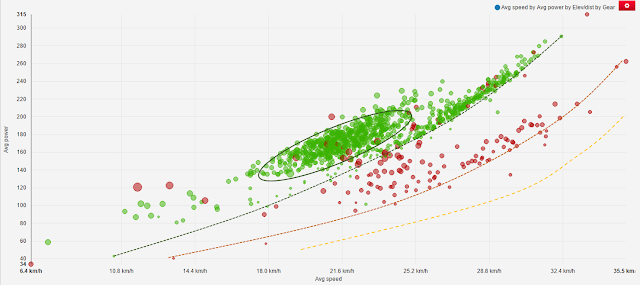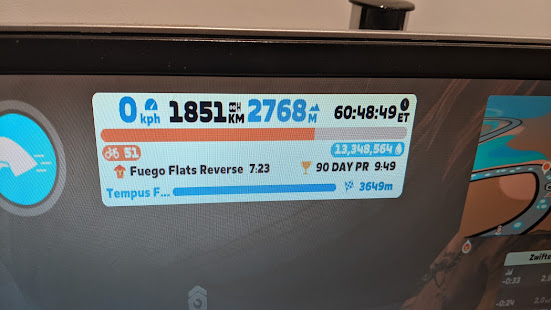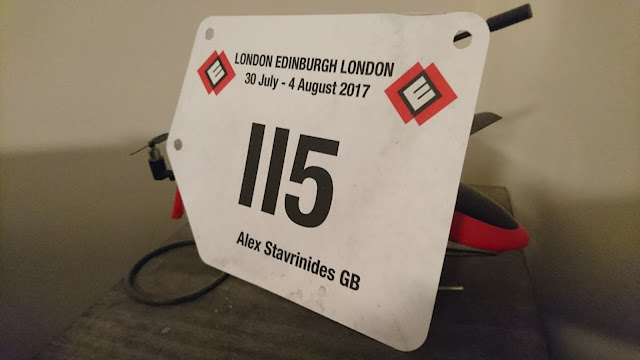3 Factors
Initially, I thought about just doing the distance. Bugger that, lets go fast!
If I want to do this fast, the way I see this challenge I have three factors to control - my rolling mass, my aerodynamics and my power output.
The second mass to have a look at is what I'll ride. I'll be on a diet, but so is my bike.
Although it would be nice to say thank you to a sponsor for a 2016 aerobike with minimum mass, I don't have that support. Neither do I have the disposable income to drop £5k on a new bike (no matter how much I'd love to). I've seen numerous charity riders spend exorbitant amounts of cash to ride a 50 mile charity ride once and then pose at the local coffee shops. My approach is different......
For this, I will be using my 1999 Concorde Alu-SL with Ultegra groupset. Why? Because even being nearly 17 years old, at around 8.5kg it's fairly light (some dieting required before 9th July) but the fit and modifications I've gone through over the years makes this bike fitted to me. The bike has a history, but the geometry is a race frame, the components I've picked over the years to suit me and I love it's handling. It may not be the most expensive, lightest or most aero, but I love it. I'll skim off some weight by replacing some of the minor parts as any mass lost from the bike is mass I don't have to move.
If I don't have to waste energy moving unnecessary mass, that's energy I can use to make me go faster or further. Sorry, don't expect in flight GoPro footage.
How much difference does mass make? Here's a GCN video to check out.
Equipment wise to reduce my frontal area, I will be using bar extensions to lower my shoulders, flatten my back and get me into a more aerodynamic pose. I won't go for full time trial bars as this is longer than the club 25 by some distance. Instead, the standard drops and extensions will allow me movement between poses to give certain muscles a break. I have already swapped my trusty carbon forks for more aerodynamic Time options. Wheel wise unless I get an opportunistic wheel package upgrade, I'll be using my Fulcrums during the day and a Fulcrum rear with a ~45mm rim and dynamo hub upfront for the night section (wheel yet to be built).
For me, I'm yet to try my new cycling onsie. It's short leg/short sleeve for the summer and as temps outside are in single digits, that'll be later this year. The idea of the skin suit will be to smooth my form as much as possible.
The final bits will be my extremities - hands, feet and head. Hands wise, I've been riding more any more mittless but I'm aware of how long these rides will be so I'll be looking at lightweight, smoothed mitts at some point. For feet, I'm currently undecided. An overshoe will smoothen and reduce drag however will risk making my feet over heat during the midday sun. The biggest factor and one of the greatest area of drag will be my helmet. Going sans helmet Marco Pantani style would be the most advantageous, but I'm not risking it. My current helmets are great for protection and venting heat in the summer, but have a higher drag coefficient so will be swapped. As the fight for room at the top is high paced since aero road helmets came into fashion a couple of years ago, anything I look at now is likely to be succeeded or trickled down to another model in the coming months, but will be a must.
For some context and links to GCN: How much faster is an aerodynamic position?
As "Aero is everything," checkout Specialized videos with wind tunnel testing.
In the graph, the green spots represent all the data points from the Genesis with the Concorde in red. The size of the dot relates to the elevation gained per unit distance (in short, larger = steeper grade for the whole ride).
The Genesis data (green)
In contrast, the red dots show the Concorde recorded data points with three characteristics.
The two bikes used in this demonstration are physically similar in terms of bike geometries but are very different in their purpose so amplifies the difference. The Genesis is highly suited to all weather, low maintenance, dependable daily commuting with my spare clothes and dinner and would be rubbish in a race. The Concorde is its antithesis so the differences between the trends are more pronounced. Had this been comparing my Concorde to a pro prepared Pinarello K8 or any of the pro-aero bikes now available, these would all be likely tracking to the right of the Concorde or roughly in the area of the yellow dashed line on the graph (and Mrs Stav would be murdering me for spending all our cash). But even so, using the Strava tools to account for weight and gradient, the trends shown are roughly in line with what would be expected.
Relating this to predicting performance, the 28.8 km/h line shows the lowest average speed limit for a 24 hour ride. Taking a rough reading from the curve for the Genesis I would have to maintain around 235 Watts to sustain this speed. To achieve the same pace using the Concorde, my average power would only have to be around 160 Watts based on the equipment and form of the past couple of years. Should I up my average power of the whole ride to around the 230 Watts mark of the Genesis (possible??) I would have a predicted speed of around 34 km/h or a time of 20.1 hours for the whole ride.
The reality of what I am wanting to do is to push/develop the curve into the bottom right corner through both human physical development and mechanical aid. Working with Lynsey and doing my training will increase my threshold and push up my sustained output for total available power and increase my W/kg for climbs. The work done over the past couple of years has looked at endurance with some nod given to aerodynamics due to my previous targets of climbing sportives or being in the bunch for the faster sportives. The use of bar extensions, skin suits and aero helmets will quickly lower my rolling drag coefficient and the weight loss from the bike will easy climbing by increasing my W/kg especially as there will be no drafts to hide in. The data used has a lot of caveats and error but demonstrates the trends I'll be looking for, the importance of equipment selection and how to evaluate performance in a real world manner. To push the curve to the right and get closer to the yellow dashed line, it'll be a mix of technology and old fashion hard work, but this is what I'll work to.
3 factors
If I want to do this fast, the way I see this challenge I have three factors to control - my rolling mass, my aerodynamics and my power output.
My power
My power output and ability to resist fatigue will be the greatest barrier and is purely dependent on my physical being - that being my genetics, biochemistry and adaption to endurance training. As my previous posts and being a test subject on the carbohydrate study look at power outputs, my work with Lynsey will look at how to increase this over the whole project. My overall biological objective will be to push my body to sustain my power output and lactate threshold high enough to sustain a pace higher enough and long enough. This all all related to my diet, time on the saddle and km's and intervals under the wheels and how to best use every session.My mass.
For my personal mass there is some variation (this will link into my power output). Previously, I'd desired a low mass and higher power output for climbing in rides like the Fred Whitton. As this year climbing will be secondary, I can afford to let my mass increase as the mass added won't have to be lifted in the same way as other years. And mass added will be beneficial - it's muscle mass that'll move me forwards.The second mass to have a look at is what I'll ride. I'll be on a diet, but so is my bike.
Although it would be nice to say thank you to a sponsor for a 2016 aerobike with minimum mass, I don't have that support. Neither do I have the disposable income to drop £5k on a new bike (no matter how much I'd love to). I've seen numerous charity riders spend exorbitant amounts of cash to ride a 50 mile charity ride once and then pose at the local coffee shops. My approach is different......
For this, I will be using my 1999 Concorde Alu-SL with Ultegra groupset. Why? Because even being nearly 17 years old, at around 8.5kg it's fairly light (some dieting required before 9th July) but the fit and modifications I've gone through over the years makes this bike fitted to me. The bike has a history, but the geometry is a race frame, the components I've picked over the years to suit me and I love it's handling. It may not be the most expensive, lightest or most aero, but I love it. I'll skim off some weight by replacing some of the minor parts as any mass lost from the bike is mass I don't have to move.
If I don't have to waste energy moving unnecessary mass, that's energy I can use to make me go faster or further. Sorry, don't expect in flight GoPro footage.
How much difference does mass make? Here's a GCN video to check out.
Aerodynamics.
As Specialised says; "Aero is everything." This will be my greatest area of energy saving and one of the most adaptive areas. The two areas to address will be me and my bike and how my bodily form works with the bike and how the bike works with me. The smaller my frontal area, the less force will be required for me to move forwards. The smoother my surfaces, the less turbulance I will cause and therefore less drag to sap away my Watts.Equipment wise to reduce my frontal area, I will be using bar extensions to lower my shoulders, flatten my back and get me into a more aerodynamic pose. I won't go for full time trial bars as this is longer than the club 25 by some distance. Instead, the standard drops and extensions will allow me movement between poses to give certain muscles a break. I have already swapped my trusty carbon forks for more aerodynamic Time options. Wheel wise unless I get an opportunistic wheel package upgrade, I'll be using my Fulcrums during the day and a Fulcrum rear with a ~45mm rim and dynamo hub upfront for the night section (wheel yet to be built).
For me, I'm yet to try my new cycling onsie. It's short leg/short sleeve for the summer and as temps outside are in single digits, that'll be later this year. The idea of the skin suit will be to smooth my form as much as possible.
The final bits will be my extremities - hands, feet and head. Hands wise, I've been riding more any more mittless but I'm aware of how long these rides will be so I'll be looking at lightweight, smoothed mitts at some point. For feet, I'm currently undecided. An overshoe will smoothen and reduce drag however will risk making my feet over heat during the midday sun. The biggest factor and one of the greatest area of drag will be my helmet. Going sans helmet Marco Pantani style would be the most advantageous, but I'm not risking it. My current helmets are great for protection and venting heat in the summer, but have a higher drag coefficient so will be swapped. As the fight for room at the top is high paced since aero road helmets came into fashion a couple of years ago, anything I look at now is likely to be succeeded or trickled down to another model in the coming months, but will be a must.
For some context and links to GCN: How much faster is an aerodynamic position?
As "Aero is everything," checkout Specialized videos with wind tunnel testing.
Bike comparisons, data analysis and the overall goal.
Checking data on different kits shows why this approach is so important. To do the 430 miles in 24 hours, I'd have to average 17.9 mph (28.8 kph) or greater. So taking my Strava data and restricting it to just the Concorde and the Genesis, I can compare how a heavier, less aerodynamic steel bike with a higher riding positions compares to the Concorde which is lighter, more aero and with a lower riding position.In the graph, the green spots represent all the data points from the Genesis with the Concorde in red. The size of the dot relates to the elevation gained per unit distance (in short, larger = steeper grade for the whole ride).
The Genesis data (green)
- The widespread nature of the Genesis data is due to traffic effects in commuting giving vastly different times over common sections (data highlighted by the green ring).
- A very clear curve and limitation is noticed running from around 18 km/h-100W through to 32.4km/h-290W. This relates to the change in commute distance and style but also towards the limit of the performance I can expect from this bike (green dashed line).
In contrast, the red dots show the Concorde recorded data points with three characteristics.
- Mixed within the green curve, red dots show where I have used the Concorde on Wednesday mornings to commute before training straight after work.
- The larger, scattered dots at the lower speeds also show the training undertaken with the specific targets of climbing.
- A curve running from around 18km/h-60W through to 35.5km/h-260W (red dashed line).
The two bikes used in this demonstration are physically similar in terms of bike geometries but are very different in their purpose so amplifies the difference. The Genesis is highly suited to all weather, low maintenance, dependable daily commuting with my spare clothes and dinner and would be rubbish in a race. The Concorde is its antithesis so the differences between the trends are more pronounced. Had this been comparing my Concorde to a pro prepared Pinarello K8 or any of the pro-aero bikes now available, these would all be likely tracking to the right of the Concorde or roughly in the area of the yellow dashed line on the graph (and Mrs Stav would be murdering me for spending all our cash). But even so, using the Strava tools to account for weight and gradient, the trends shown are roughly in line with what would be expected.
Relating this to predicting performance, the 28.8 km/h line shows the lowest average speed limit for a 24 hour ride. Taking a rough reading from the curve for the Genesis I would have to maintain around 235 Watts to sustain this speed. To achieve the same pace using the Concorde, my average power would only have to be around 160 Watts based on the equipment and form of the past couple of years. Should I up my average power of the whole ride to around the 230 Watts mark of the Genesis (possible??) I would have a predicted speed of around 34 km/h or a time of 20.1 hours for the whole ride.
The reality of what I am wanting to do is to push/develop the curve into the bottom right corner through both human physical development and mechanical aid. Working with Lynsey and doing my training will increase my threshold and push up my sustained output for total available power and increase my W/kg for climbs. The work done over the past couple of years has looked at endurance with some nod given to aerodynamics due to my previous targets of climbing sportives or being in the bunch for the faster sportives. The use of bar extensions, skin suits and aero helmets will quickly lower my rolling drag coefficient and the weight loss from the bike will easy climbing by increasing my W/kg especially as there will be no drafts to hide in. The data used has a lot of caveats and error but demonstrates the trends I'll be looking for, the importance of equipment selection and how to evaluate performance in a real world manner. To push the curve to the right and get closer to the yellow dashed line, it'll be a mix of technology and old fashion hard work, but this is what I'll work to.




Comments
Post a Comment